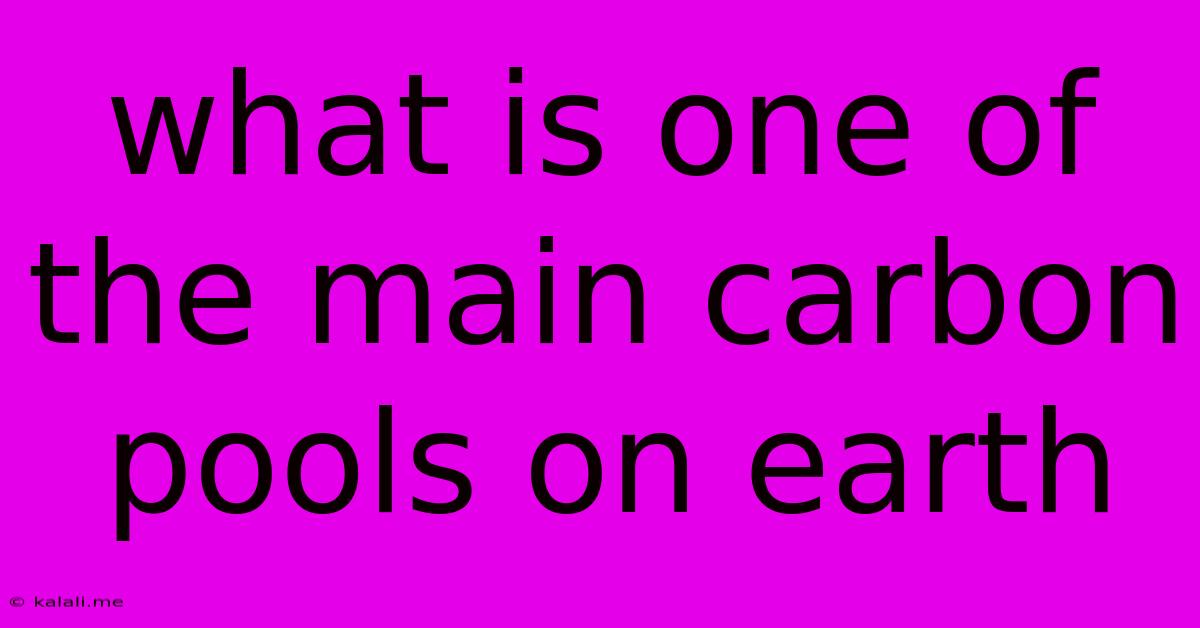What Is One Of The Main Carbon Pools On Earth
Kalali
May 10, 2025 · 3 min read

Table of Contents
What is One of the Main Carbon Pools on Earth? Understanding the Ocean's Crucial Role
The Earth's carbon cycle is a complex system involving the exchange of carbon between various reservoirs, or carbon pools. These pools store carbon in different forms, for varying lengths of time. While several significant carbon pools exist, including the atmosphere, terrestrial biosphere (plants and soil), and sedimentary rocks, one of the main carbon pools on Earth is the ocean. This article will explore the ocean's vital role in regulating the planet's carbon cycle and the implications of its changing dynamics.
The ocean's vastness makes it a truly enormous carbon sink, absorbing a significant portion of the carbon dioxide (CO2) released into the atmosphere. This absorption is a critical process, mitigating the effects of human activities like burning fossil fuels and deforestation that release excess CO2 into the atmosphere, contributing to global warming and climate change. Understanding the ocean's capacity as a carbon pool is vital for predicting future climate scenarios and developing effective mitigation strategies.
How the Ocean Stores Carbon
The ocean stores carbon in several forms:
-
Dissolved Inorganic Carbon (DIC): This is the largest component of the ocean's carbon pool, comprising dissolved CO2, bicarbonate ions (HCO3-), and carbonate ions (CO32-). The ocean's vast volume allows it to absorb and hold massive amounts of DIC.
-
Organic Carbon: This includes dissolved organic carbon (DOC) and particulate organic carbon (POC). Phytoplankton, microscopic marine plants, use CO2 during photosynthesis to produce organic matter. This organic matter forms the base of the marine food web and, upon death and decomposition, contributes to the ocean's carbon store. Deep ocean currents play a crucial role in transporting this organic carbon to the deep sea, where it can be stored for long periods.
-
Inorganic Carbon in Sediments: Over geological timescales, the accumulation of calcium carbonate (CaCO3) shells and skeletons from marine organisms forms massive carbonate deposits on the ocean floor. These sediments act as a long-term carbon sink, though this process is slower than the absorption of DIC.
The Ocean's Changing Role
While the ocean plays a vital role in regulating atmospheric CO2 levels, its capacity is not unlimited. The increasing amount of CO2 being absorbed is leading to several significant changes:
-
Ocean Acidification: Increased CO2 absorption leads to a decrease in pH, making the ocean more acidic. This acidification threatens marine ecosystems, particularly those organisms that build their shells and skeletons from calcium carbonate, such as corals and shellfish.
-
Changes in Ocean Circulation: Alterations in ocean currents can impact the efficiency of carbon transport and storage in the deep ocean. These changes are complex and are still being actively researched, but they pose a potential threat to the ocean's ability to function as a carbon sink.
-
Impact on Marine Life: Changes in ocean chemistry and circulation can significantly alter marine ecosystems, leading to shifts in species distribution, abundance, and overall biodiversity.
Conclusion: The Ocean's Importance in Climate Regulation
The ocean's role as a major carbon pool is undeniable and profoundly important for regulating the Earth's climate. However, the increasing absorption of CO2 is impacting the ocean in significant ways, highlighting the urgent need for strategies to reduce atmospheric CO2 emissions and protect this critical component of our planet's carbon cycle. Further research and conservation efforts are essential to ensure the continued health of our oceans and their ability to mitigate climate change. Understanding the complexities of the ocean carbon cycle remains a crucial aspect of climate science and future environmental policy.
Latest Posts
Latest Posts
-
How Many Tbsp In A Dry Ounce
Jul 02, 2025
-
How Do You Say Grandparents In Spanish
Jul 02, 2025
-
How Many Numbers Are Between 48 To 24
Jul 02, 2025
-
How Many Positions Are There In Sex
Jul 02, 2025
-
How Many Minutes Are In 10 Miles
Jul 02, 2025
Related Post
Thank you for visiting our website which covers about What Is One Of The Main Carbon Pools On Earth . We hope the information provided has been useful to you. Feel free to contact us if you have any questions or need further assistance. See you next time and don't miss to bookmark.